| Name | Bone File – Double-Ended |
| Lead Time | Lead time advised within 48 hours of order placement. |
| Specialty | Neuro, Ortho & Spine-Rasps & Files |
| Material Finish | Stainless Steel |
| Grade | Premium Operating Room |
| Units of Measurement | Each |
| Manufacturer | Nine H Surgical |
| Sterility | Non-Sterile |
| Usage | Reusable |
Bone File – Double-Ended
double-ended, cross-cut, 7″ (18.0 cm) Bone File is a highly versatile instrument that can be used in a vast array of surgical procedures. This file is double ended and is cross cut. The small paddle style blades allow it to be used near delicate tissue areas as are common in neurosurgical procedures and not cause trauma or injury by puncture wound. Additionally use of this file on jagged bone breaks or cuts or even on rough hard surfaces aids in the protected of neurovascular bundles and other tissue layers that are mobilized during surgery that can easily be torn or injured.
SKU:
FI-01-1238
Category: Rasps & Files
Description
Reviews (0)
Be the first to review “Bone File – Double-Ended” Cancel reply
Shipping & Delivery
Related products
Bone File – Single-Ended
single-ended, 2-sided convex & flat blade, 23.0 mm width tapers to 6.0 mm, 11" (28.0 cm) Bone File is a ideally suited for many different surgical procedures. It is specifically designed to be used to file away at bone fragments that are caused by breaks or cuts or on coarse hard tissues in different parts of the body. They can be especially useful in neurosurgical and orthopedic procedures that can involve maneuvering and exploring around many different bony areas such as the skull, long bones and vertebral column. Additionally this file is single sided with a convex and flat blade and a 23.0 mm width that tapers to 6.0 mm.
Bone File #33
double-ended, plain serrations, 6.0 mm & 5.0 mm wide ends, 7" (17.5 cm) Bone File #33 is ideally suit for use in neurosurgical and orthopedic surgeries that require manipulation of bone in and around delicate tissue structures. This type of instrument can be useful in filing down the skull in procedures like craniotomies or in reshaping the vertebral arch during laminectomies or hemi-laminectomies. This gives added protection to the brain tissue or neurovascular bundles that can pass over these cut surfaces that may be jagged and could cause additionally injury or trauma. Additionally this file is double ended with plain serrations and features a 6.0 mm and 5.0 mm wide ends.
Bone File #64
double-ended, plain serrations, 3.0 mm & 4.0 mm wide, 7" (17.5 cm) Bone File #64 is a double ended instrument that can be used in a variety of surgical procedures. This file features plain serrations and can be used to smooth out sharp edges on bone during surgery. In surgeries where such delicate tissue is involved such as nerves, vessels or even brain tissue it is imperative to keep sharp surfaces from causing tear injuries. Additionally this instrument is comprised of premium German operating-room grade stainless steel.
Gallaher Rasp
straight, coarse teeth, 6.5" (16.5 cm) Gallaher Rasp is ideally suited for use in shaping or whittling down bone and other hard tissue. It can aid in prevention of further trauma or injury to soft tissue layers such as brain in craniotomies or to the spinal cord or neurovascular bundles in laminectomies. A unique feature of this rasp is the additional loop affixed to the base of the handle for placement of the thumb for added grip and maneuvering. Additionally this rasp is straight and features coarse teeth.
Miller-Colburn File
double-ended, down-cutting teeth, medium & large ends, octagonal handle, 7-1/4" (18.4 cm) Miller-Colburn File can be used to soften jagged edges or rough surfaces on bone or other hard surfaces. This file features a slim, octagonal body shaft that doubles as a handle from which two different sizes blade extend on either side. Both ends features down-cutting teeth that allow it to grab hold and uniformly file away at a surface such as the skull or vertebral fragment to protect surrounding tissue from damage in craniotomies or spinal surgeries.
Polokoff Rasp
Polokoff Rasp is a highly versatile instrument that is ideal for use in neurosurgical or orthopedic surgical procedures that require manipulation of bone. This rasp can be used to reshape bone slightly to prevent snagging of delicate tissue layers of vasculature. Additionally it can be used to hollow out bone to aid in insertion of implants. This rasp is double-ended and available in two sizes either 3.0 mm and 4.0 mm ends or two 6.0 mm ends making it suitable for a vast majority of patient cases.
Putti Bone Rasp – Flat Blades
flat blades, double-ended flat blades, 18.0 mm width tapers to 4.0 mm, 1 end curved up, 1 end curved sideways, 10-1/2" (26.5 cm)Putti Bone Rasp is an instrument ideally suited for use in surgeries that require handling and particularly mild reshaping of bone such as in neurosurgical or orthopedic surgeries. . This instrument is double ended and features two flat blades. The unique design of this rasp is in the leap shaped silhouette that tapers from 18.00 mm to 4.0 mm that allows it to be fit into slim and narrow spaces and effectively whittle down bone or hard tissue from any angle.
Putti Bone Rasp – Round Blades
round blades, double-ended, 1 10.0 mm round blade tapers to 4.0 mm & 1 15.0 mm half-round blade tapers to 5.0 mm, 12" (30.5 cm) Putti Bone Rasp is an instrument ideally suited for use in surgeries that require handling and particularly mild reshaping of bone such as in neurosurgical or orthopedic surgeries. . This instrument is double ended and features one round blade and another half round. The unique design of this rasp is in the leap shaped silhouette that tapers from 11.0 mm to 4.0 mm for the round blade and from 15.0 mm to 5.0 for the half round that allows it to be fit into slim and narrow spaces and effectively whittle down bone or hard tissue from any angle.


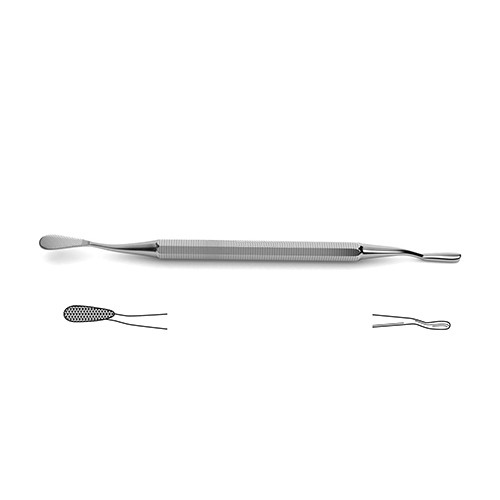

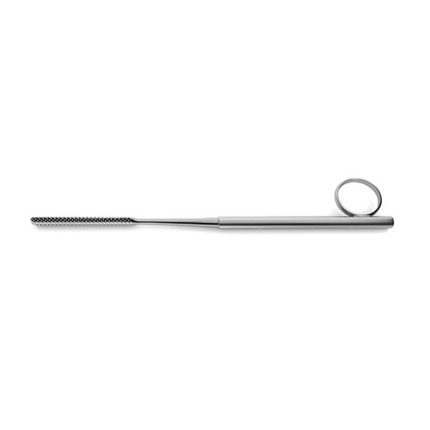
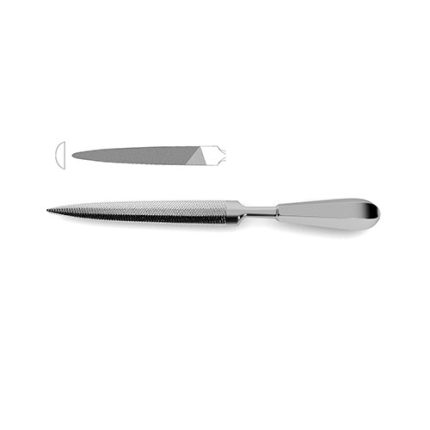

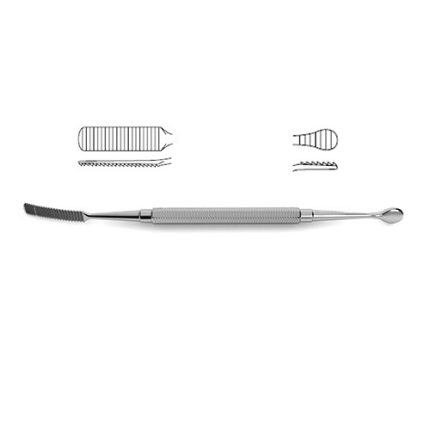
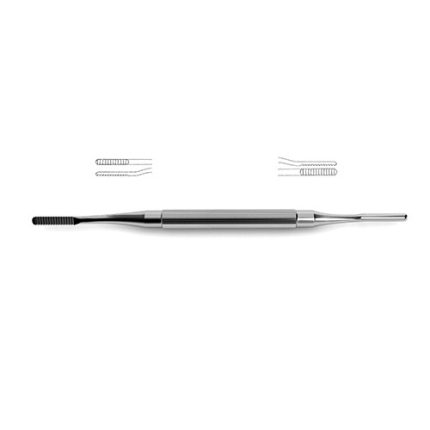
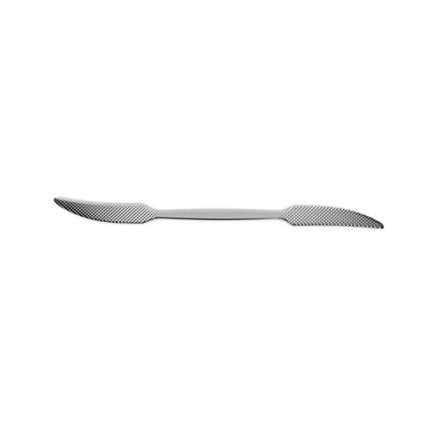
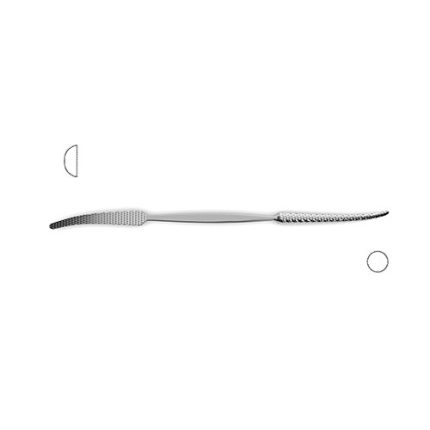
Reviews
There are no reviews yet.